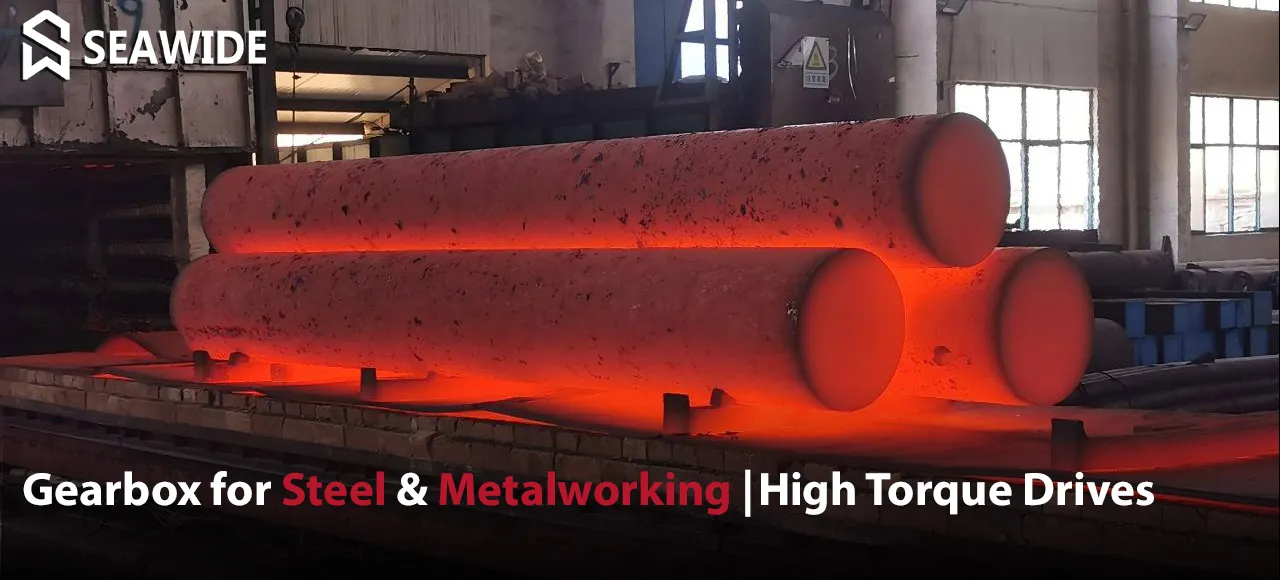
In the demanding world of gearboxes for the steel and metalworking industry, SEAWIDE heavy‑duty gear units deliver precise, durable power transmission under extreme mechanical and thermal conditions—continuous duty, high torque, abrasive dust, shock load, and elevated temperatures. Engineered to maintain flawless performance in core plant operations such as rolling, forging, pressing, conveying, and furnace handling, these robust drives ensure stability and strength where torque density and heat resistance define production reliability.
Built on proven engineering standards and tested for resilience in high‑impact environments, SEAWIDE gearboxes provide exceptional endurance and long‑term dependability. Across the industry’s diverse machinery range—from gearboxes for steel rolling mills and drive gearboxes for mill stands, to gear reducers for forging presses, gearboxes for furnace rollers, and cooling line conveyors—each SEAWIDE unit balances compact design, torque output, and mechanical efficiency to support uninterrupted operation in 24/7 manufacturing cycles.
By understanding specific torque demands and load profiles within steel production lines, plant engineers can optimize equipment performance, reduce maintenance intervals, and achieve significant energy savings. Designed and validated according to ISO 6336 gear‑load standards, SEAWIDE drives ensure reliable power delivery for heavy‑load mill sections, roller tables, and vertical forming systems. Recognized for its superior torque density and thermal endurance, the planetary gearbox remains the ideal solution for modern metalworking applications—providing precision motion, mechanical strength, and extended service life while maintaining SEAWIDE’s hallmark 30 % cost advantage in every line configuration.
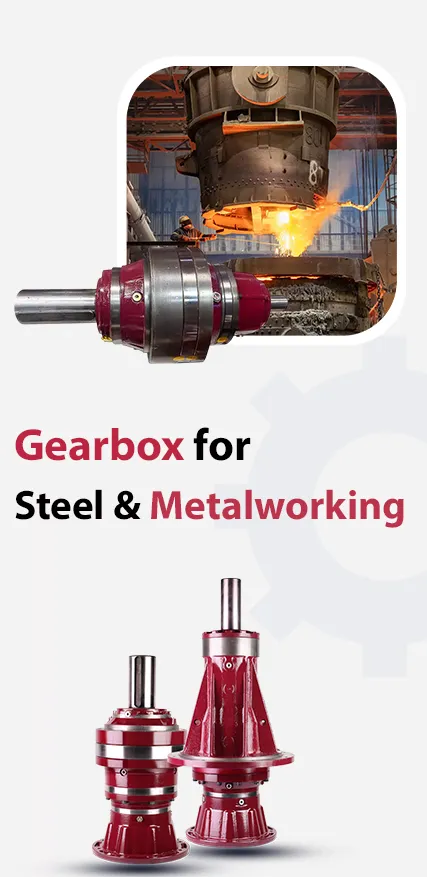

Industrial gearboxes for the metalworking and steel industry come in several configurations, each serving precise duties within heavy‑load manufacturing systems.
Helical Gearboxes: Deliver smooth, high‑efficiency torque transmission for rolling mills, continuous casting drives, and strip conveyors.
Bevel Gearboxes: Redirect motion at 90 ° efficiently—ideal for furnace rollers, cooling lines, and elevator mechanisms.
Worm Gearboxes: Provide high reduction ratios with compact, self‑locking operation for lifting, tilting, and maintenance cranes.
Spur Gearboxes: Simple, reliable options for feeders, shears, and auxiliary conveyors where steady output and low noise are required.
Cycloidal Gearboxes: Precisely handle cyclic shocks in forging and stamping presses under extreme impact conditions.
Planetary Gearboxes: Compact drive systems offering high torque density, perfect for mill stands, ladle turrets, and heavy‑duty rotary tables.
Planetary Gearbox Supplier | Gearbox for Sale & price-SEAWIDE
Other Configurations: Parallel‑shaft or hypoid gearboxes manage special motion sequences and nonstandard layouts in metallurgical lines.
Among these, SEAWIDE gearboxes are designed for the harshest workloads—combining thermal stability, torque endurance, and dimensional precision for long‑cycle steel production.
Built to endure shock loads, heat, and alternating duty cycles, SEAWIDE industrial drives guarantee exact torque delivery and smooth motion control across all forming and handling stations.
From rolling mills and forging presses to furnace conveyors and coilers, each gearbox variant offers the best match of torque output, footprint, and durability. Every unit is developed to maintain alignment accuracy and resist wear caused by metal scale, vibration, and temperature fluctuations.
High Torque Range: Up to 1,000,000 Nm depending on model and ratio configuration.
Endurance: Heavy‑duty housings and sealed components guarantee reliability under heat and dust.
Efficiency: Up to 98 % mechanical output through optimized gear geometry and surface hardening.
Shock Load Resistance: Absorbs torque peaks 5× above rated levels in pressing and rolling operations.
Flexible Mounting: Horizontal / vertical configurations adaptable to complex plant layouts.
Stable & Quiet: Precision machining lowers vibration and sound emissions for continuous lines.
Maintenance Access: Modular construction allows rapid ratio or bearing replacement.
Beyond mechanical performance, SEAWIDE gearboxes offer measurable lifecycle value. Their modular layout simplifies maintenance, enabling servicing without dismounting the full drive train and reducing downtime. Integrated condition‑monitoring options (temperature, vibration, torque sensors) support predictive maintenance and extend operating life under intense production cycles.
With their combination of efficiency, durability, and smart serviceability, SEAWIDE gearboxes deliver an optimized total cost of ownership across steel‑making and metal‑forming environments.
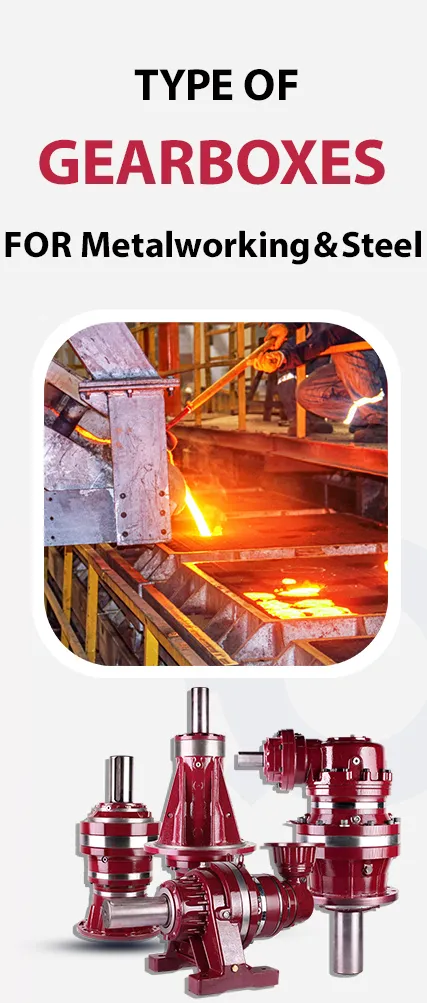
Helical gearboxes with angled teeth (15-30°) deliver smooth torque transfer and quiet operation through gradual tooth engagement. Built with high-grade shafts, gears, and bearings in rugged housings, they handle reduction ratios up to 100:1 and torque up to 500,000 Nm. Efficiency ranges from 90–95%, operating reliably between -10 °C and +60 °C under continuous industrial loads.
Advantages: Reliable torque transmission, reduced vibration (<75 dB), installation flexibility, and simple maintenance in dusty, hot steel-plant environments.
Applications: Rolling-mill drives (steady high-torque feed), forging-press conveyors (continuous duty), coilers and de-coilers (high load wrapping), ladle tilt mechanisms, and cooling-bed transfer lines. Helical units are dependable but take more space than planetary gearboxes and offer slightly lower efficiency in confined layouts.
Planetary gearboxes use a sun gear, planet gears, and a ring gear to deliver extreme torque density in a compact assembly. The design distributes load evenly and minimizes backlash, ideal for high-torque continuous duty in mills and presses with frequent reversals. Torque up to 1,200,000 Nm, efficiency >95%.
Advantages: Excellent torque-to-weight ratio, compact footprint for retrofits, superior shock resistance, and high positional accuracy during forming cycles.
Applications: Rolling-stand main drives, forging-press feed systems, furnace rollers, coil-handling units, and billet pusher mechanisms. Although more costly than helical types, planetary gearboxes provide unrivaled durability and efficiency where space and precision matter.
Planetary Gearbox Supplier | Gearbox for Sale & price-SEAWIDE
Bevel gearboxes use conical gears to redirect motion by 90°, providing ratios up to 6:1, torque capacity to 100,000 Nm, and efficiency around 90–92%.
Advantages: Compact and robust for angular mounting, resistant to dust and metal scale, and effective for elevated temperature operations.
Applications: Transfer-table drives, furnace lift systems, and de-scaler carriages requiring directional torque transfer. Reliable but less suited to the largest press or mill torques where planetary designs dominate.
Worm gearboxes feature a worm shaft engaging a worm wheel, achieving large reduction ratios (up to 100:1) with self-locking action. Typical torque around 50,000 Nm; efficiency 50–90%.
Advantages: Compact, stable in cyclic loads, and prevents back-driving under press or lift operations.
Applications: Roller and chain drives for auxiliary handling, hood positioners, and cooling-bed mechanisms operating at low speeds. Drawbacks include heat buildup under continuous service and lower efficiency compared to helical or planetary gearboxes.
Spur gearboxes use straight-cut teeth on parallel shafts for simple and accurate power transmission. Ratios up to 10:1, torque to 200,000 Nm, efficiency 94–98%.
Advantages: Simple design, cost-efficient production, and low maintenance downtime.
Applications: Shear drives, feed rollers, sheet levelers, and auxiliary transfers where compactness and simplicity are favored. Noisier and less refined than helical or planetary units but practical for medium-duty motion tasks.
Cycloidal gearboxes employ eccentric cams and needle-roller tracks for high reduction (up to 100:1) and torque capacity up to 500,000 Nm with 90–95% efficiency.
Advantages: Excellent shock absorption, precise motion control, and strong overload tolerance.
Applications: Automation lines for metal forming, press feeders with variable speed, coil-handling devices, and robotic arms in foundries. Pricier than helical types but preferred for accuracy and shock resilience in precision steel-forming systems.
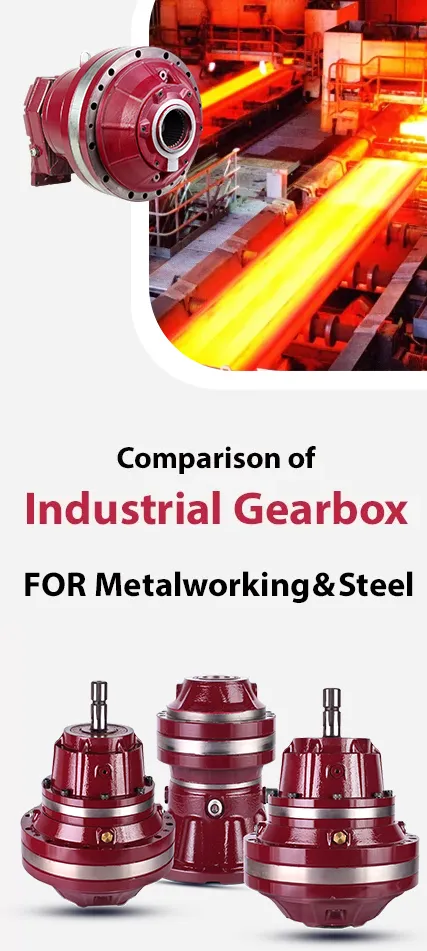
| Gearbox Type | Torque (Max Nm) | Efficiency | Compactness | Best Steel Use | Key Limitation |
|---|---|---|---|---|---|
| Planetary | 1,200,000 | >95% | High | Main drives for rolling mills, forging presses, and coil unwinders | Higher cost |
| Helical | 500,000 | 90–95% | Moderate | Feed conveyors, cooling beds, coilers, and shears | Larger footprint in tight layouts |
| Bevel | 100,000 | 90–92% | High | Transfer tables, furnace lifts, descaler carriages | Limited ratio range |
| Worm | 50,000 | 50–90% | High | Auxiliary handling, chain lifts, or small roller systems | Lower efficiency under continuous duty |
| Spur | 200,000 | 94–98% | Low | Sheet levelers, feeders, and trimming lines | Noisy at high speed |
| Cycloidal | 500,000 | 90–95% | High | Press feeders, coil manipulators, and precision handling lines | Higher initial cost |
In the steel and metalworking industry, high‑precision and heavy‑duty machinery drive the core stages of rolling, forging, cutting, and coil processing. Each unit operates under extreme torque, shock, and thermal stress, demanding robust power‑transmission systems to ensure continuous reliability and productivity. Durable industrial gearboxes—engineered for efficiency, heat resistance, and compact strength—play a pivotal role in maintaining uninterrupted performance in harsh plant environments.
Below, we introduce major steel‑sector machinery one by one, detailing core functions, the most suitable gearbox configurations (with balanced focus on planetary and helical units for torque density and shock absorption), gearbox advantages, and essential criteria for correct gearbox selection. This section complements our detailed guide to industrial gearboxes in metalworking and steel applications, offering practical insights for engineers aiming to achieve higher equipment uptime, energy efficiency, and precision control across forming, rolling, and conveying lines.
By highlighting planetary and helical gearboxes—recognized for efficiency above 95%, torque ratings exceeding 1,000,000 Nm, modular multi‑stage ratios up to 10:1 per stage, and superior resistance to cyclic stress—we reinforce their position as the most dependable choice for demanding operations involving rolling mills, forging presses, and coil‑handling systems in modern steel plants.
In steel and metalworking facilities, every mechanical stage—from rolling and forging to cutting and coil handling—depends on precise and resilient power transmission. Industrial gearboxes convert motor energy into controlled torque, ensuring steady motion, forming, and material conveying under extreme temperature, shock, and load conditions.
Rolling mill gearboxes are heavy‑duty power‑transmission units designed to handle extreme torque and cyclic shocks in hot and cold steel‑rolling lines. Their main function is to drive the roll stands that compress billets or slabs into precise cross‑sections under continuous load. Each gearbox must maintain torque stability to ensure accurate reduction ratios, speed synchronization, and durable performance across multi‑stand mill setups.
Optimal Gearbox Type: Planetary‑helical combination or High‑torque helical gearbox — selected for compact strength, vibration control, and long service life in continuous rolling‑mill duty.
Features of the Device: Handles torque ranges up to 1 MN·m with roll speeds between 20 and 200 rpm; supports both reversing and non‑reversing mills; provides near‑zero backlash transmission for section, sheet, and strip rolling lines. Integrated oil cooling and hardened shafts tolerate ambient heat and metallic dust typical of steel plants.
Features of the Gearbox: Reduction ratios 10:1–25:1; power capacity up to 1,200 kW; efficiency >95%; modular casing for quick assembly; high‑load bearings with axial rigidity for precise roll alignment. Equipped with forced lubrication and temperature sensors for predictive maintenance. Compact planetary input increases torque density while keeping the footprint minimal.
Selection Considerations: Confirm mill configuration (2‑high, 4‑high, or 6‑high) and torque peak factors before ratio design; define thermal class according to rolling schedule; verify coupling alignment under thermal expansion; consider housing stiffness for vibration damping and extended bearing life.
With optimized planetary‑helical gear drives, rolling mills achieve stable torque delivery, minimize downtime by up to 30%, and secure uniform strip quality and energy efficiency critical for modern steel production lines.
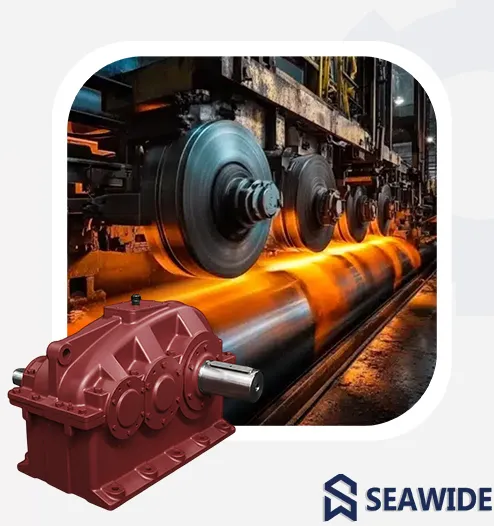
Hot rolling lines transform heated steel slabs into strips, bars, and sections under severe mechanical stress and temperatures that often exceed 1100 °C. Each stand or finishing mill requires a high‑torque gearbox capable of continuous operation, absorbing dynamic loads, and ensuring synchronized roll motion throughout the production train. Torque stability directly defines product thickness accuracy and reduces downtime caused by gear overheating or vibration.
Optimal Gearbox Type: Heavy‑duty Planetary‑Helical or Parallel‑Shaft Helical Gearbox — selected for compact torque transmission, superior thermal resistance, and long service intervals under hot‑mill duty cycles.
Features of the Device: Continuous torque demands 0.8 to 1.2 MN·m; input speeds 100–800 rpm; coupled to 3‑phase AC or DC main drives up to 1.5 MW; temperature gradients between stands require independent lubrication and water‑cooled housings. The mill structure must sustain axial and bending stresses during billet reduction.
Features of the Gearbox: Multi‑stage ratios 12:1 to 28:1; gear efficiency >94%; case‑hardened steel gears with surface hardness >60 HRC; thermally stabilized shafts; dual‑circuit oil cooling with heat exchanger; vibration isolation pads; online temperature monitoring. Planetary input enhances torque density without increasing footprint.
Selection Considerations: Confirm torque peaks and overload factor (1.8–2.0× nominal); choose proper cooling method (oil + water or forced air); specify bearing class C3 for thermal expansion; align couplings considering chock movement; ensure gear lubricant meets ISO VG 320 class for hot environments.
Designed for endurance in continuous hot‑rolling service, these high‑torque gearboxes deliver stable motion, minimize maintenance interruptions by 30%, and preserve dimensional precision across heavy‑duty steel production lines.
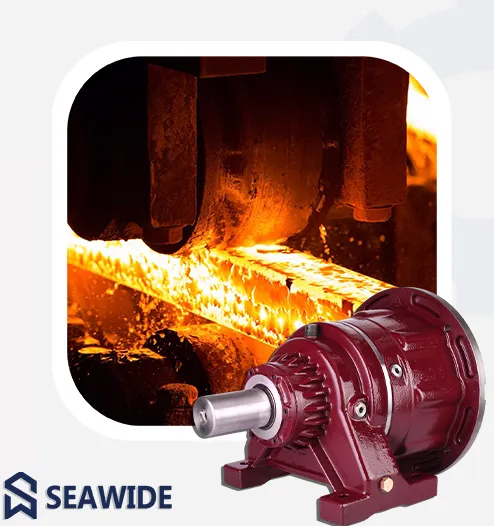
Mill stand drive gearboxes are critical components in rolling mill systems. They transfer power from the main motor to the roll pairs that reduce billets into sections or plates. These gearboxes operate under high torque, cyclic loads, and continuous reversing duty, ensuring smooth roll engagement and stable thickness accuracy along the production line.
Optimal Gearbox Type: Planetary-Helical or Parallel-Shaft Helical Gearbox – designed for high torque output, compact form, and precise shaft-center alignment under repetitive load cycles.
Features of the Device: Torque capacity up to 1,000,000 Nm; input speed 100–600 rpm; mounted between main motor and mill stand coupling; bidirectional operation for reversing mills; rigid foundation for shock absorption; oil cooling and temperature sensors to support continuous rolling under thermal load.
Features of the Gearbox: Gear ratios 10:1 to 28:1; efficiency above 95%; carburized and ground gears with hardness above 58 HRC; flexible shaft alignment for easy maintenance; precision bearings with high axial stiffness and low vibration (<0.01 mm); forced lubrication with oil monitoring and heat exchanger.
Selection Considerations: Review the load diagram of the mill stand before ratio design; define torque peaks and thermal class for continuous operation; choose between splash or forced lubrication depending on ambient temperature; verify alignment tolerance between drive and stand rolls to reduce bearing wear.
By integrating a heavy-duty gearbox into the drive-to-mill-stand system, rolling lines maintain smooth synchronization, extend uptime by up to 30 percent, and achieve reliable dimensional control across high-torque operations.
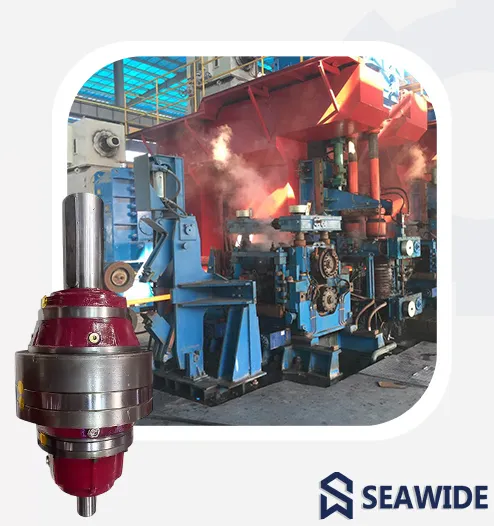
Furnace roller gearboxes power the rollers that move heated slabs or sheets through reheating and annealing furnaces in steel plants. Each roller operates continuously under extreme temperatures and radiant heat, where stable motion and accurate speed control prevent surface defects and uneven heating across the length of the workpiece.
Optimal Gearbox Type: Helical or Worm Gearbox – designed for smooth rotation, thermal resistance, and low-speed high-torque output required for furnace conveyors.
Features of the Device: Operates near heat zones up to 600 °C; typical roller torque from 500 Nm to 3000 Nm; continuous duty cycles exceeding 20 hours; installed with water–cooled or air–cooled housings; coupling designed for positional accuracy under thermal expansion.
Features of the Gearbox: Ratio range 15:1 to 40:1; efficiency above 90%; case‑hardened helical or worm gears; specialty seals to prevent lubricant oxidation; high‑temperature bearings rated to 250 °C; robust cast‑iron housing ensuring stability and low vibration.
Selection Considerations: Verify furnace temperature profile and roller pitch; check lubrication type (high‑temp synthetic oil ISO VG 460); confirm bearing clearance for thermal growth; prefer gearboxes with detachable cooling jackets and service‑friendly seals.
By adopting a dedicated gearbox for furnace rollers, steel plants achieve steady slab movement, lower maintenance frequency, and up to 30 percent more uptime in continuous hot‑processing lines.
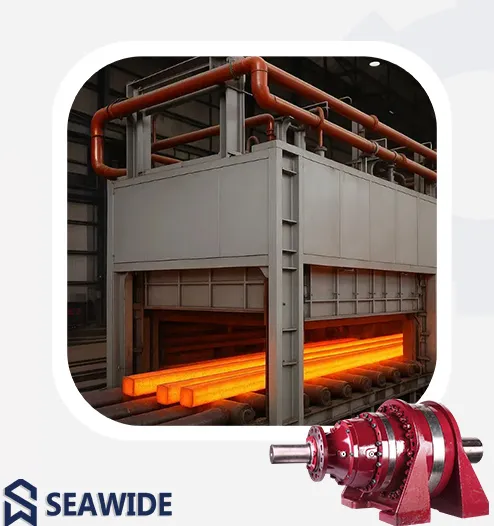
Steel cooling lines handle slabs or strips exiting hot rolling mills, transporting them through controlled air or water zones to achieve uniform temperature drop and metallurgical stability. Gearboxes in this section ensure smooth, synchronized roller motion under large thermal gradients and intermittent loads during transition from hot to cold processing stages.
Optimal Gearbox Type: Helical or Worm Gearbox – chosen for quiet operation, corrosion resistance, and consistent low‑speed performance in humid or high‑temperature environments.
Features of the Device: Sustains torque between 1,000 Nm and 6,000 Nm; operates near cooling baths with high moisture; continuous duty cycle in low‑speed conveyor rollers; mounting designed for sealed enclosures and minimal maintenance; built to resist condensation and scale deposition.
Features of the Gearbox: Ratio range 12:1 to 40:1; efficiency above 90%; precision‑cut helical gears; nitrided shafts to prevent thermal fatigue; double lip seals against vapor ingress; optional stainless‑steel housing for cooling line durability; lubrication system compatible with water‑resistant oils ISO VG 220.
Selection Considerations: Review cooling line configuration and roller spacing; check torque peaks and temperature fluctuation; specify IP‑rated enclosures for humidity; verify lubricant selection based on ambient dew point; use flexible couplings to handle thermal misalignment.
A well‑sealed helical or worm gearbox in the steel cooling line improves uptime by up to 30 percent, ensuring steady slab movement and uniform cooling across continuous production operations.
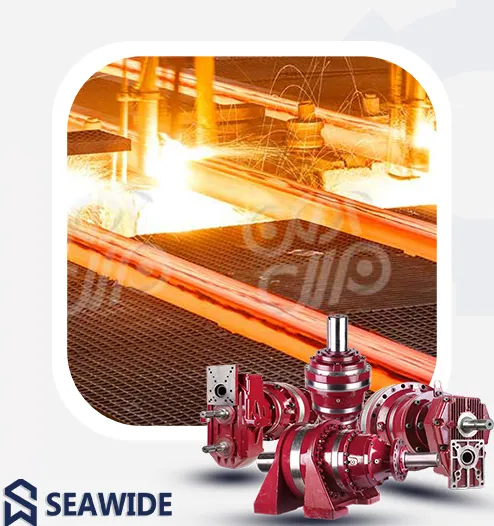
Continuous annealing lines process cold‑rolled steel strip in a seamless path through heating, soaking, and cooling zones to refine the grain structure and improve ductility. Each section requires accurate strip tension and synchronized roller motion, where gear reducers maintain continuous strip flow without slip or distortion.
Optimal Gearbox Type: Helical or Planetary Gear Reducer – ensures precise torque transmission, smooth acceleration, and compact design suited for tension bridles and furnace roller drives operating in high‑temperature zones.
Features of the Device: Drives tension bridles, entry and exit reel rollers, and furnace conveyors; typical torque from 1,500 Nm to 12,000 Nm depending on roller diameter; duty cycle 24/7; installed along multiple drive stations with frequency‑controlled motors for synchronized speed regulation.
Features of the Gearbox: Ratio range 10:1 to 50:1; efficiency > 94%; case‑hardened steel gears; high‑temperature grease type ISO VG 460; thermal‑stable seals; heavy‑duty housing with precision alignment for strip tension stability; optional integrated torque arm for compact drive modules.
Selection Considerations: Verify strip width and line speed to calculate required torque; choose reducers with dynamic balancing for roller drives; specify cooling provisions in furnace area; ensure fine backlash control (< 5 arc‑min) to prevent tension fluctuation; prefer modular planetary stages for easy maintenance.
Proper gear reducer configuration in a continuous annealing line guarantees uniform strip tension, reduced surface defects, and up to 30 percent less unplanned downtime across full‑length coil processing operations.
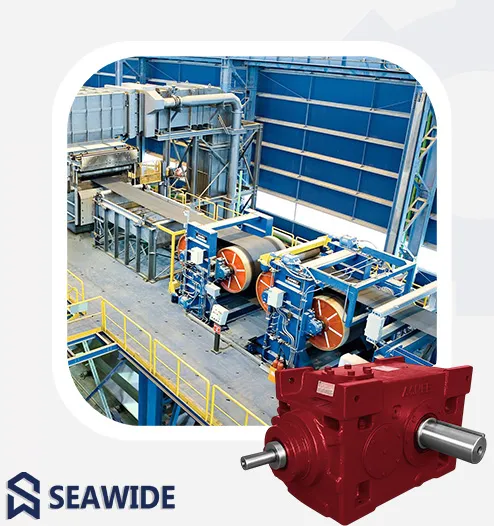
Ladle cars move molten steel or slag between melting furnaces and casting stations inside steel plants. The gearbox in each driving axle provides the torque required to transport heavy ladles, often exceeding 100 tons, under extreme heat and shock loads. Reliable motion control prevents spillage and ensures continuous casting operations without delay.
Optimal Gearbox Type: Planetary or Helical Gearbox – engineered for high torque density, compact build, and excellent shock‑load resistance suitable for traction drives of ladle transfer cars.
Features of the Device: Carries molten metal ladles weighing 80 to 150 tons; operates within ambient temperatures up to 300 °C near furnace zones; duty cycle intermittent but high‑torque bursts; driven by variable‑speed motors; equipped with cooling ducts and heat shields to protect drive assemblies.
Features of the Gearbox: Torque range 50 kN·m to 200 kN·m; ratio 20:1 to 40:1; efficiency > 93%; carburized and ground gears for long wear life; special high‑temperature seals and labyrinth ventilation; thermally insulated housing; heavy anti‑shock bearings and double support shafts for stable traction.
Selection Considerations: Confirm total ladle weight and gradient of track; check traction torque for starting under load; specify gearboxes with heat‑resistant paint and reinforced shafts; align lubrication system with ambient temperature; design mechanical brakes integrated into gearbox output for safety.
A robust gearbox system on ladle cars guarantees safe molten‑steel handling, precise speed control, and up to 30 percent lower maintenance frequency in hot‑metal transport operations.
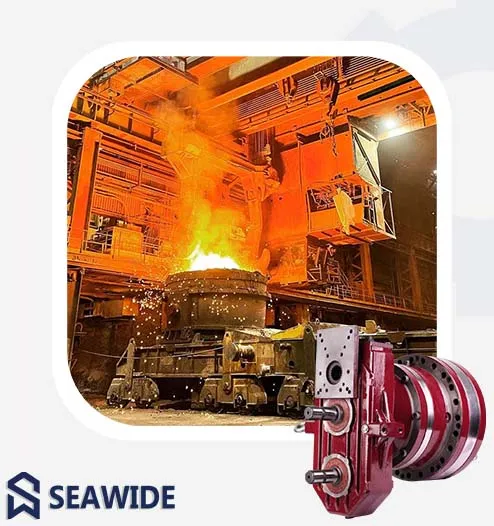
Conveyor gearboxes provide steady motion and torque transmission for material‑handling systems that move billets, slabs, or scrap metal across rolling, cooling, and loading sections in steel plants. These drives maintain continuous flow of materials under high load and abrasive environments, supporting uninterrupted production logistics.
Optimal Gearbox Type: Helical or Planetary Gearbox – selected for high efficiency, long service life, and resistance to shock loads in belt or chain conveyors handling heavy steel components.
Features of the Device: Operates on continuous duty with torque requirements from 2,000 Nm to 30,000 Nm; supports conveyor speeds 0.3 to 3 m/s; designed for dusty and oily surroundings; integrated base for easy alignment with drive pulley; fitted with temperature sensors in bearings for predictive maintenance.
Features of the Gearbox: Ratio range 10:1 to 60:1; efficiency > 94%; hardened and ground helical gear profiles; heavy‑duty bearings; grease or oil lubrication systems selectable per location; optional backstop mechanism for inclined conveyors; cast‑iron or steel welded housing for maximum rigidity and vibration absorption.
Selection Considerations: Evaluate conveyor length and load capacity; determine required torque and reduction ratio from motor power; choose gearboxes with IP 65 or higher sealing rating for mill areas; verify thermal rating > 2 kW/°C for continuous operation; include maintenance access ports for regular inspection.
A properly configured conveyor gearbox ensures consistent material transfer across steel manufacturing zones, reducing downtime and achieving up to 30 percent higher line reliability and energy efficiency.
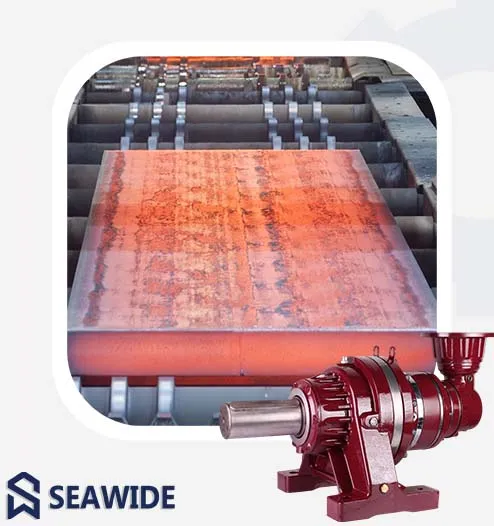
Metal presses used in forging, stamping, or deep‑drawing operations require massive torque peaks and precise motion cycles. The gearbox converts motor power into controlled ram movement, ensuring repeatable press strokes with high forming accuracy and long mechanical life under extreme loads.
Optimal Gearbox Type: Planetary or Helical Gearbox – chosen for superior torque density, compact size, and accurate positioning suited for main press drives and screw‑type or crank‑type mechanisms.
Features of the Device: Handles pressing forces up to 2,000 tons; operates in high‑impact cycles at low speed; intermittent duty with rapid acceleration and deceleration; equipped with flywheel or servo motor coupling; mechanical design allows bidirectional rotation and overload protection.
Features of the Gearbox: Torque range 30 kN·m to 400 kN·m; ratio 5:1 to 40:1; efficiency > 93%; carburized gears with surface hardness > 58 HRC; heavy‑duty roller bearings; oil bath lubrication with forced cooling for continuous production; optional angular output or vertical mounting configuration for press pit layouts.
Selection Considerations: Determine maximum forming tonnage and stroke speed; specify backlash tolerance under 3 arc‑min for precision presses; check shock‑load factor > 2.0; use vibration‑damped couplings; confirm gearbox thermal rating for short‑cycle operation and motor synchronization during heavy impact.
A well‑matched gearbox for metal presses provides accurate stroke control, high productivity, and up to 30 percent lower energy consumption and maintenance costs in metal‑forming installations.
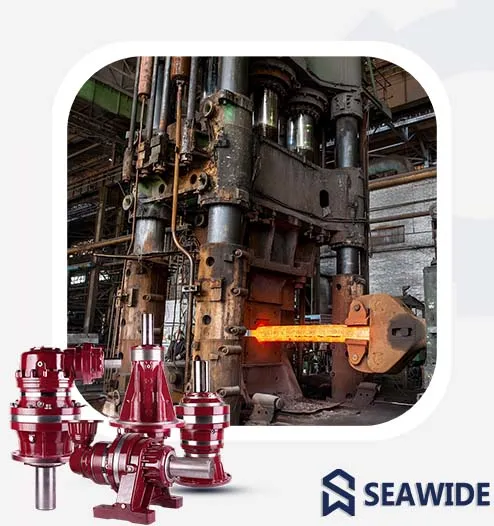
They are built from high‑grade alloy steel and designed to handle extreme loads and thermal conditions common in rolling mills and foundry lines.
Depending on the configuration, torque output ranges from 1,500 Nm up to over 12,000 Nm, ensuring stable power transmission in continuous duty environments.
All models deliver over 94% mechanical efficiency, with optimized gearing geometry to minimize energy loss and vibration under high load.
Yes — Seawide engineers design gearboxes with ratios from 10:1 to 50:1, adjustable according to line speed, motor power, and process requirements.
The housings use heat‑resistant lubrication systems and precision seals that allow operation near furnaces and cooling sections without performance drop.
Absolutely. Each gearbox can be fully customized, and the technical team provides complete design assistance for torque, ratio, and mounting configuration selection.
Seawide gearboxes can integrate a circulating oil system with temperature monitoring, ensuring stable lubrication and gear performance in long, high‑load production cycles.
Each gearbox is supplied with precision mounting references and optional on‑site alignment support to guarantee smooth torque transmission and reduced vibration during operation.
